|
|
|
|

Caucasian Regional Studies
What Is Wrong With Armenia
by Richard Beilock
*
Introduction
In some respects little is, or appears to be, wrong with Armenia. Internal political dissention is largely peaceful, crime is reasonably low, and moderate progress has been made regarding legal and regulatory reforms. There has also been growth. In 1992 and 1993, Armenia (unofficially) fought a war with Azerbaijan over an Armenian-majority area within Azerbaijan, Nagorno Karabakh. Since the cease-fire the economy has grown at an average annual rate of 7 percent. 1 But growth is slowing and Armenia is poorer today, both in absolute and relative terms, than it was at the end of the Soviet era. In 1989 among the Republics of the Soviet Union, Armenia had the 4th highest per capita real income. That income was equal to those of Estonia and Latvia, 92 percent of Lithuania's, and 86 percent of Russia's. By 1997, Armenia's per capita real income was less than half the level of 1989. Among the countries of the Former Soviet Union (FSU), Armenia had slipped to 7th place, with a per capita real income 62 percent of Latvia's, 57 percent of Lithuania's and Russia's, and 47 percent of Estonia's. 2 Moreover, among 11 FSU countries and 10 nations of Central and Eastern Europe (CEE), the European Bank for Reconstruction and Development (EBRD) estimates Armenia's growth rate over the next 25 years will be the third lowest, marginally ahead of Moldova and FYR Macedonia. 3
It will be argued that Armenia's transition to a viable market economy is stalled and in danger of remaining so indefinitely. The country is becoming locked in a caricature of its Soviet past, albeit with a liberal façade. Armenia has exchanged:
| Dependence on Moscow for cheap resources and assured markets | for | Dependence on Western assistance and remittances from workers living abroad |
| Trade constrained by Cold War alliances | for | Trade constrained by its enmities with Azerbaijan and Turkey |
| A corruption-ridden government bureaucracy with a Communist face | for | The same, but with a market veneer. |
In many respects, this new situation is less appealing and no more sustainable than what existed in the Soviet Union. However, unlike under the Soviets, correcting the situation is entirely within the power of the Armenian people and its Government. Twenty-five years from now, Armenia may: 1. be little changed, despite growth in neighboring countries or 2. enjoy a living standard equivalent to the current levels of Turks, Lebanese, and Costa Ricans or 3. enjoy a living standard equivalent to the current levels of the Portuguese and Spanish (see Figure 1).

Any of the above scenarios is possible and, in large measure, within the control of the Armenian people and its government. The first scenario assumes low levels of investment, both foreign and domestic; poor relations with actual or potential trading partners; inefficiency and corruption in government; unnecessarily high transportation costs; and unstable international conditions, with the attendant heavy military burdens. To a great extent this describes the current situation. The second scenario assumes EBRD's 25 year average growth rate projection for Armenia. With this growth rate, Armenia would become richer in an absolute sense, though poorer relative to its neighbors. But the future can be much brighter. The final scenario assumes EBRD's 25 year growth rate projection for Estonia. 4 The main point of this paper is that if the Government and people take appropriate actions, it is entirely possible for Armenia to equal or exceed this growth rate.
The central roles of investment and trade
At present, Armenia is a poor country with a narrow base of natural resources and an inadequate capital stock. 5 The domestic market is exceedingly small and, by itself, could attract and support only limited development. To convey a sense of this, based on its purchasing power parity GDP, the Armenian economy is equivalent to a U.S. city of 325,000 (such as Peoria, Illinois). Based on the dollar value of its GDP [probably the more relevant measure for foreign investors and international trade], the Armenian economy is equivalent to a U.S. city of 57,000 (such as La Crosse, Wisconsin). In isolation Armenia will remain poor. There simply is not yet a sufficient market to attract and hold the needed investments and talents, both domestic and foreign. Armenia's development, then, depends crucially on its integration into the larger economic settings of its region, surrounding regions, and the world. Without international trade, Armenia will not be able to secure the range of goods and services required to raise living standards; and without investment, Armenian businesses will not have the tools and technologies to compete in world markets.
Determinants of investment and trade
In the lower left of the figure is Resource Endowment and Geographic Factors (REGF). This includes such things as mineral endowments; climate; soil quality; proximity to large markets; and the availability of harbors and navigable rivers or the presence of natural barriers, such as mountain chains. Clearly, these factors impact on trade opportunities and, in turn, investments.
The three shaded boxes are primarily in the public sector or subject to close regulation. In the lower right is Infrastructure and Government Institutions (IGI). Infrastructure includes roads, railroads, water systems, and other capital areas within or under regulatory supervision of governments, such as telecommunications. By ?Government Institutions' is meant those units which directly interact with the business community, such as taxing and licensing authorities, customs, police, and the judiciary. Like REGF, the quality and nature of IGI impacts on trade opportunities and investments. For example, a poorly performing Customs Service or inadequate road system can discourage trade and, as a result, also discourage investment. The arrow from IGI to REGF indicates that infrastructure can alter the impacts of REGF. For example, a tunnel can reduce the costs of crossing a mountain barrier or an irrigation system can ameliorate climatic factors.
The Domestic Political Situation impacts upon the performance of Government Institutions and investment incentives. If there is political instability domestically, government agencies are likely to operate poorly. This, along with security and other problems normally associated with political instability, can raise the cost of doing business, thereby lowering investment incentives. Finally, the International Political Situation impacts on Investment and Trade and REGF. For example, risk of war can lower prospects for trading and jeopardize the security of investments. Trade embargoes and blockades can alter the effective or usable resource and geographic endowments.
Each of these factors will be discussed to assess those areas where Armenia could effect improvements which would contribute significantly to the realization of prosperity. The principle data sources are described in the Appendix.
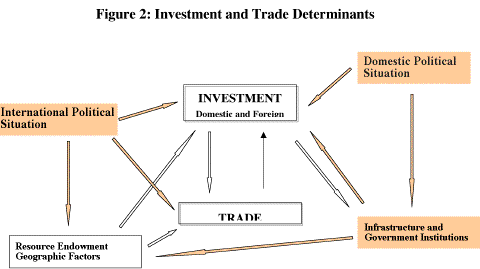
Overview of the current investment and trade situations
Investment
By virtually any measure, investment levels are poor in Armenia. EBRD reports that total investment equals 8.8 percent of GDP, among the lowest in the Former Soviet Union (FSU) and Eastern Europe, see Figure 3. The very low investment rate is particularly surprising in view of the large volume of assistance to the country. As a percent of GDP, Armenia receives more Official Development Assistance than any other nation in the FSU and Eastern Europe, see Figure 3. For other nations Official Development Assistance is a fraction, usually a small fraction, of total investment amounts, while for Armenia, Official Development Assistance is more than twice that of investment. In addition to Official Development Assistance, Armenia receives large cash infusions from the Diaspora and remittances from Armenians working abroad. The extent of these transfers is unknown, but may exceed half a billion dollars annually. 6 Clearly, the very large majority of these infusions are being used for current consumption, often on imports, or are leaking out of the economy as capital flight, rather than being used for investment. Unless the inflow of funds from Official Development Assistance, the Diaspora, and remittances is considered to be permanent, Armenia is living beyond its means and squandering an opportunity for achieving sustained growth. 7
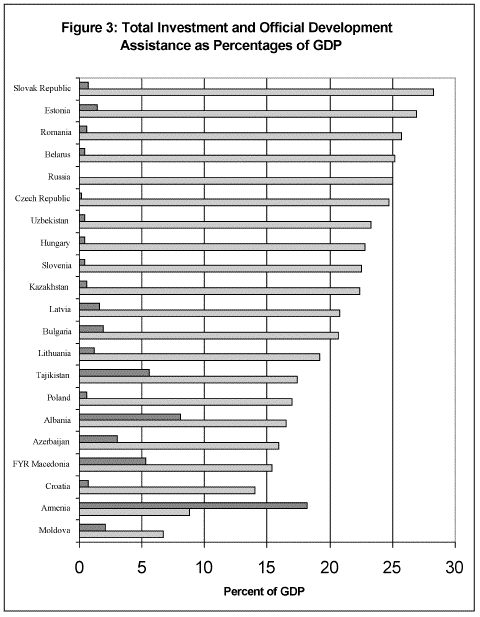
Not only is the overall investment rate low, investment by foreigners is low. In 1997 there was $52 million in Foreign Direct Investment (FDI) in Armenia. 8 In terms of GNP, Purchasing Power Parity GDP, or on a per capita basis, this is one of the lowest FDI rates in the FSU, see Figures 4 and 5.

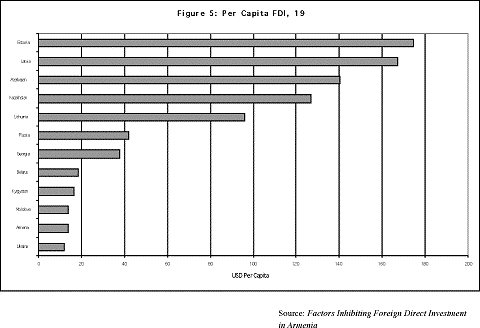
Trade
Low Export Levels
Nations with narrow resource bases, such as Armenia, must acquire goods and services from other countries to realize prosperity and even for basic survival. But goods and services from abroad must be paid for and, ultimately, this means that the country must sell its own goods and services to the world. 9 In Figure 6, the percent exports represent of purchasing power parity GDP is presented for twenty small nations with narrow resource bases. Armenia's exports are only 2.5 percent of its purchasing power parity GDP. This is the amount of foreign credits Armenia actually earns and can apply to the acquisition of foreign goods and services for consumption and investment without incurring debts or otherwise relying on external support. This amount, 2.5 percent, is barely a third that for Moldova and Mongolia. For most of the nations shown, many of which are formerly socialist countries, exports account for around 20 percent or more of purchasing power parity GDP.
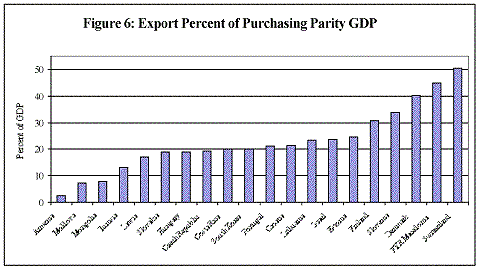
Deteriorating Trade Balance
Armenia's external trade performance is deteriorating. Between 1994 and 1997, export levels were stagnant, while imports more than doubled, see Figure 7. Armenia now imports nearly four times the value of goods and services that it exports. There is evidence that this imbalance is even more severe among Armenian-owned businesses. An estimated 75 percent of their inputs are imports, while only 3 percent of their sales are exports, see Figure 8. 10 Relative to purchasing power parity GDP, Armenia's trade imbalance is worse than all other FSU countries, with the exception of the Baltic nations (Figure 9). The Baltic nations have high overall investment rates (Figure 3). So it is likely that some or all of their trade deficits are being used to create the productive capacities to expand exports and/or reduce dependence on imports. This is not the case for Armenia. There is little evident progress toward expanding its export capacity. To finance imports Armenia's dependence is growing on debt and external grants (including Official Development Assistance, gifts from the Diaspora, and remittances). It is highly doubtful this is a sustainable situation and, even if sustainable, it cannot lead to prosperity.
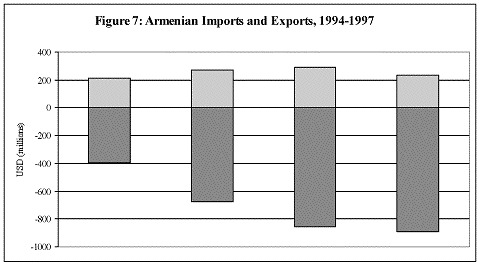
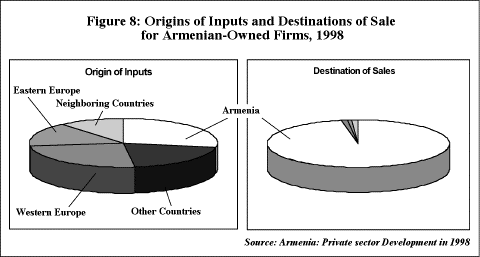
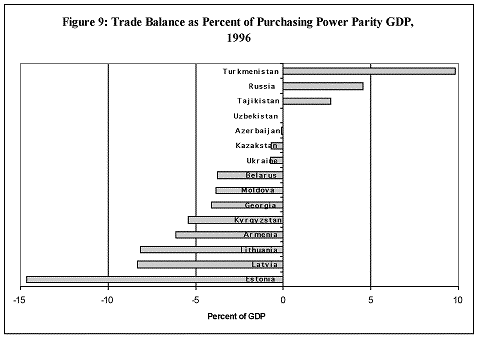
Reduced Benefits From FDI
FDI directed at the domestic market can improve the efficiency with which a nation provides goods and services for itself, but at the cost of profit repatriation by the foreign investors. 11 With export-generating FDI, there still are the efficiency benefits and foreign investors still repatriate profits. But the exports expand the ability of the nation's citizens to purchase foreign goods, services, and assets without obligation, including the assets of that foreign investor. Armenia's low and essentially flat export trend suggests that most FDI to date has been for serving the domestic market, rather than for developing exports. As repatriation is in the foreign investor's currency, foreigners with investments geared to serving the Armenian market ultimately are seeking foreign exchange in Armenia. It cannot be stressed enough that FDI is beneficial as it enhances internal efficiency and production capacity. It should be recognized, however, that there is a degree of circularity in the current situation: foreign exchange enters Armenia via assistance, gifts from the Diaspora, remittances, and modest levels of exporting, and foreign investors come to develop businesses to take some away. The solution is not to restrict FDI, but to enhance the attractiveness of Armenia as a platform for exporting.
Resource Endowment and Geographic Factors
Resources
Armenia's overall natural resource endowment is poor to moderate. The country does possess some mineral wealth, such as gold, iron, copper, and building stone. But these are clearly insufficient for growth. Due to its dry climate, high altitudes, and generally poor soils, Armenia's agricultural potential is limited. While there is some scope for agriculture-based specialty products, such as wine and fruits, Armenia is and will continue to be a net importer of foods and fibers. Finally, Armenia's energy resources are very poor.
Armenia's People
Armenia's poor natural resource base does not condemn its people to poverty. Indeed, many of the world's richest peoples are in areas with poor natural resource bases. Examples of these are: Switzerland, the Netherlands, Belgium, the Republic of Ireland, Massachusetts, Denmark, South Korea, Taiwan, Japan, pre-civil war Lebanon, the Czech Republic, and Israel. A poor natural resource base, however, does force reliance upon the skills, initiative, and ingenuity of its people. Current foreign investors and experts on the Armenian economy identify low labor costs and good labor force qualifications as the two most important incentives for investing in Armenia. 12 Low wage rates are not desirable, but it should be recognized that only with development can Armenian wages rise without widespread unemployment. 13
Geographic Factors
In some respects, Armenia's geographic setting is extremely disadvantageous. The country is landlocked and remote from the very large markets of Europe, East Asia, and North America. While it is close to the Russian border, access is limited by mountain barriers and most of Russia's main population centers are far to the north. Under the best of circumstances, reaching these markets entails high transport costs which tend to raise the overall costs of imports and lower the net returns of exports for Armenia. 14 Because of their sheer size, trade with these markets will always be important for Armenia. The costs imposed by geography can be reduced through efficient transport and concentration on cargoes with high values per unit weight and volume. But these costs cannot be eliminated. Armenia's physical isolation inevitably reduces the benefits of its transactions with these distant markets. Armenia should seek opportunities for trade in the region and surrounding regions.
The proximities and the sizes of the economies of other nations normally are extremely powerful determinants of trade volumes. This is particularly likely to be true when transport costs per unit distance are high, as is the case for Armenia. So it would be of value to consider those areas most readily accessible to Armenia. This will be referred to as Armenia's ?Immediate Trading Neighborhood.' Armenia is well-placed to serve markets throughout the Transcauscasus, eastern and southeastern Anatolia, northwest Iran, and the central Caucasus, see Figure 10. This Immediate Trading Neighborhood, though small in terms of world markets, offers considerable opportunity for Armenia. It has nearly 50 million people and a purchasing power parity GDP of $100 billion. 15 In terms of GDP, East/Southeast Anatolia and Northwest Iran together account for nearly three quarters of Armenia's Immediate Trading Neighborhood, with Georgia, Azerbaijan, and the Central Caucasus almost evenly dividing the remainder, see Figure 11. 16
Figure 10:


There is internal unrest and/or poor environments for business in many areas of Armenia's Immediate Trading Neighborhood. For example, much of East/Southeast Anatolia is subject to disturbances related to Turkey's Kurdish minority; there are conflicts or potential conflicts throughout much of the Central Caucasus, and institutional support is poor for business in many areas of Azerbaijan and Georgia. In the short run, this can actually work to Armenia's advantage. Armenia has the potential to be a relatively safe and business-friendly platform for firms interested in marketing to the Immediate Trading Neighborhood. For example, a Turkish firm might select Yerevan as a centrally-located, secure venue for supplying goods to East/Southeast Anatolia, Azerbaijan, and Northwest Iran. In the medium and long term, however, peace and prosperity throughout the Immediate Trading Neighborhood is in everyone's interest, including Armenia's.
International Political Situation
The international political situation can strongly influence, positively or negatively, the volumes of investment and trade a nation enjoys, as well as its effective resource endowment and geographic factors. For the Armenian economy, the international political situation has been largely negative. The overriding factor, in this regard, is the blockade against Armenia by Turkey and Azerbaijan and the potential for renewed hostilities with Azerbaijan. This results in increased uncertainty and costs and reduced trading opportunities. The blockade effectively worsens geographic factors for Armenia and reduces the value of resources, such as building stone, which otherwise could be sold to neighbors but are normally unsuited for longer distance trade. Investment is discouraged and trade levels are both lower and dollar-for-dollar yield less benefits for Armenia than would be the case with no blockade.
Higher Transport Costs
The high transport costs for Armenian imports and exports are due, at least in part, to the blockade. Georgia and Iran are Armenia's only gateways for surface movements. Recognizing Armenia's limited options, the Georgian Government has placed low priority on maintenance and repair of the railroad and roadways nearest to the Armenian border. Armenian imports and exports are subject to higher tariffs on the Georgian Railway than virtually all other freight. Limited options also give power to those with interests to raise transport costs, either through increasing legitimate rates or corruption. Freight forwarders report costs for transporting containers from Poti to Yerevan are around $2,000. 17 This is equivalent to the cost of moving a container from New York to Seattle, nearly ten times the distance. These high costs directly tax the Armenian-based shippers and receivers, discourage investments and trade, and lower the economic potential of Armenia.
The blockade impedes trade with Iran by raising transport costs. The road distance is approximately 350 kilometers from Yerevan to Tabriz, the principle city of Northwest Iran, via either Turkey or Nakhichevan, But the distance is nearly 50 percent longer using the routing through Armenia to the Iranian border. Moreover, this routing passes through some extremely high and difficult terrain. The blockade also denies Armenia access to the rail link to Iran via Nakhichivan. It seems likely that without the blockade transport costs between the two countries would be a third to half lower.
Altered Mixes of Goods Traded and Trading Partners
Almost certainly the most severe effect of the current international situation is that opportunities are denied to purchase imports more cheaply and to sell exports for higher net returns. Not only are trade levels lower due to the blockade, the mixes of goods traded and of trading partners are altered. For example, as transport costs are heightened and some nearby trading opportunities eliminated, the impacts of the blockade are disproportionately severe on heavier, lower valued goods, such as building stone, and goods with special requirements, such as produce, flowers, and meats. In terms of purchasing power parity GDP, the blockade almost totally eliminates trade between Armenia and 44 percent of its Immediate Trading Neighborhood (Azerbaijan and East/Southeast Anatolia) and raises transport costs to another 38 percent (Northwest Iran), see Figure 11. In the following box, it is conservatively estimated that without the blockade, Armenia's exports to Azerbaijan and Turkey would be $62 million and that this would increase Armenia's GDP by over $180 million.
With a political settlement, investment levels, from both FDI and domestic sources, would also be expected to increase and burdens from military expenditures would decrease. As a result, Armenia's long term growth rate would rise. Referring back to Figure 1, an easing of the international political situation would contribute greatly to Armenia having the type of future currently projected for Estonia, rather than the much less enviable one currently projected for itself. This does not necessarily mean that Armenia should seek a political accommodation or in any way indicate what the terms of such an accommodation should be. That is a political decision for the Government of Armenia and the other affected governments. But the Government should be cognizant that the costs of the maintaining the current situation are significant and will span generations. They and their children will be poorer.
Domestic Political Situation
Internal Violence
It is difficult for business to flourish in uncertain environments. Uncertainty with regard to domestic politics can reduce incentives for investment directly and through its impacts on Government institutions. One aspect of uncertainty is risk of internal violence. In this regard, Armenia can be judged positively. While there have been a few assassinations, overall Armenians appear committed to the political process. Since the election of the Kocharian Government, political demonstrations have been peaceful, almost without exception. Moreover, there have been no politically-motivated actions against the business community, foreign or domestic. This cannot be said for many areas of the CIS or for Armenia's Immediate Trading Neighborhood.Changes In Government Officials
Another aspect of uncertainty related to the domestic political situation are changes in the government officials with whom businesses must interact. In this regard, Armenia's performance is poor. For example, during 1998, the majority of Ministers in the Kocharian Government changed and management of Customs changed three times. The appropriateness of these changes is not questioned. But an inevitable result of change is uncertainty, which discourages investment and may result in inconsistent performance of government institutions. These impacts are likely to be severe if changes of top officials result in rapid and widespread changes throughout the organization and if unsystematic, relationship-based interactions are important when businesses interact with government. Both of these are the case in Armenia.
Interviews with various experts, both in and out of Government, indicate that changes in top officials of a ministry or agency typically result in widespread changes throughout the entire organization. These changes are frequently based primarily on political considerations, rather than knowledge or skills. To provide programmatic and administrative continuity, there is no cadre of civil servants who are expected to be apolitical and insulated from politically-motivated personnel changes. 18
There is strong evidence that interaction with Armenian Government officials is frequently based on personal relationships, rather than rules and regulations. For example, 90 percent of a sample of foreign businesspersons with investments in Armenia 19 agreed or strongly agreed with the following statement:
Successful business in Armenia is really based on relationships with powerful political/economic groups.
Some of these investors indicated problems because they had explored "investments based on connections with specific government officials" 20 and these officials lost their positions. From the same study, the large majority of a panel of government and non-government experts on the Armenian economy expressed opinions that businesses face arbitrariness and inconsistency in their dealings with the Government. As a result of arbitrary treatment and despite laws to the contrary, frequently there is unequal treatment of foreign and domestic investors. 21
Infrastructure and Government Institutions
Infrastructure
Much of Armenia's infrastructure is in need of maintenance and upgrading. However, at the present time, inadequate infrastructure does not appear to be a primary impediment to business in Armenia. The very low current level of economic activity is the principle reason for this. For example, the Armenian Railway owns 84 electric and 122 diesel locomotives. Of these, only 27 electric and 9 diesel locomotives are operational. 22 In addition, due to problems with rails, cross ties, signaling, and electricity, train speeds along the main line average less than 40 kilometers per hour. However, the railroad moves 8 percent of the tonnage it did ten years ago and, even in its current condition, there is ample capacity. Clearly, it is vital to maintain the current infrastructure and, in some cases, to effect upgrades. If and as there is economic development, the areas needing upgrades will expand. But at the current time, infrastructure is essentially a neutral factor regarding the attractiveness of Armenia for business and investment.
Government Institutions
Well operating government institutions would be a powerful incentive for business and investment in Armenia. Unlike other factors, such as resource and geographic endowments and international politics, the performance of its government institutions is entirely under Armenia's control and ability to change. Tragically, performance levels have been inconsistent and generally poor. It is evident that poor performance of government institutions is a major impediment to investment and overall business activity in Armenia. Over three quarters of a sample of foreign investors in Armenia agreed or strongly agreed with the first statement below, and nearly 90 percent agreed or strongly agreed with the second statement. 23
Bureaucratic red tape is the main factor inhibiting business activity in Armenia.
Businesses frequently have to pay [government officials] some irregular "additional payments" to get things done.
This is a scathing indictment of the Armenian Government's role in promoting the economic wellbeing of its people. Indeed, this suggests that the reverse is the case.
While business's problems dealing with Government range across a broad spectrum of ministries, agencies, and levels (i.e., including regional and municipal), the three areas most frequently resulting in difficulties are Customs, the Tax Inspectorate, and Traffic Police. Both Armenian and foreign businesspersons 24 also indicate considerable problems with and distrust of the court system. For example, a startling 97.5 percent of government and non-government experts indicated that the Armenian court system was neither fair nor predictable.
Red Tape
Interactions by business with the Armenian Government can be frustrating and lengthy. Fifty-five percent of a sample of foreign investors in Armenia report that their managements currently devote over 15 percent of their time to dealing with the Government. This is over five times the incidence reported for OECD countries, nearly twice that reported for Central and East European Countries, and equal to the overall average reported for the CIS, see Figure 12. Moreover, the situation appears to be deteriorating. Nearly one in four of the firms reporting that they now devote over 15 percent of management time dealing with the Armenian Government indicated that this was not the case two years ago.
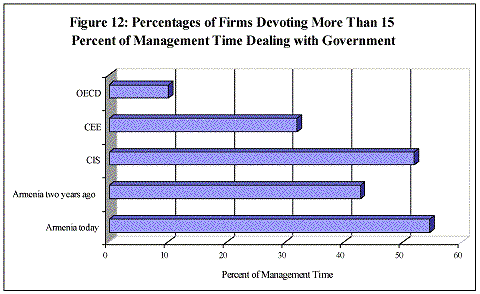
Clearing cargoes through borders is a case in point. Freight forwarders report the following average times for clearing cargoes through the border from Georgia into Armenia. 25
| Hours to clear cargoes through border from Georgia into Armenia | ||
|---|---|---|
| |
Via Road | Via Rail |
| Without bribes | 35.2 | 29.9 |
| With bribes | 11.2 | 25.9 |
Opaque and Changeable Laws, Regulations, and Procedures
Despite some improvements, many of Armenia's business-related laws, regulations, and procedures remain opaque and are subject to unexpected changes. This creates problems for both foreign and Armenian businesses. In a sample of government and non-government experts in Armenia, 91, 77, and 80 percent, respectively, disagreed with or strongly disagreed with the following statements. 26
Most needed laws and regulations are clear and easy to follow.
Most needed laws and regulations are in place and working.
Any changes in laws and regulations are consistent and predictable.
The World Bank study of Armenian businesses concluded that:
Overall, Armenian firms find legal instability a major constraint. They are moderately constrained by the excessive complexity of laws and regulations, by the lack of transparency of formal rules ("difficulty of knowing"); and by the failure of both the courts and the government to apply important laws and regulations. Legal instability, unpredictability, obscurity, and inconstant enforcement each deter long-term and complex commitments, and raise the cost of both inter-firm and government-firm transactions. 27
Finally, Armenia is rated by EBRD 28 among the very worst of the CIS, the Baltic States, and Central and Eastern Europe in terms of government policy risk, see Figure 13. EBRD defines government policy risk as business risk associated with unpredictable legal and regulatory processes.

Corruption
Corruption is a serious and widespread problem in Armenia's Government. The Wall Street Journal panel of regional analysts judged Armenia's corruption level, along with those of the other CIS countries, as markedly worst than the Baltic Republics and Eastern and Central Europe, see Figure 13. While Armenia's score is better than many of the CIS countries, the differences are slight. Echoing these sentiments, 87 percent of a panel of government and non-government experts on the Armenian economy judged corruption to be a problem for business. 29 Some insight into the pervasiveness and frequency of this problem may be gleaned from the following. Freight forwarders 30 report that on average a bribe or other irregular payment is solicited by:
Armenian Customs on 56 percent of all shipments
Traffic Police on 23 percent of all shipments
Armenian Rail Officials on 53 percent of all shipments.
Conclusions
The implications of the preceding analysis are relatively straightforward. To promote growth and enhance the economic welfare of its people, the Government of Armenia:
Appendix: Principle Data Sources
Investigation of Factors Inhibiting Foreign Direct Investment in Armenia
A 1998 survey of current and potential foreign investors in Armenia and of government and non-government experts on the Armenian economy. In addition, a review of relevant Armenian laws was carried out. The study was funded, primarily, by US AID and carried out by the IRIS Caucasus Center and the Ministry of Industry and Trade.
Transportation Intermediary Survey: Georgia and Armenia, 1998
A 1998 survey of virtually all active freight forwarders in Georgia and Armenia. The survey addressed all aspects of transport, including related institutions, such as Customs and Police. The study was done by the author for USAID.
Armenia: Private Sector Development in 1998
A 1998 survey of 200 Armenian businesses for the World Bank by Andrew Stone.
Transition Report 1997: Enterprise Performance and Growth
An annual publication of the European Bank for Reconstruction and Development. The 1997 issue contains reports on several relevant studies.
Notes
Note *: Richard Beilock is Professor of Food and Resource Economics, University of Florida, e-mail: beilock@fred.ifas.ufl.edu Back.
Note 1: Based on World Bank purchasing power parity estimates for 1993 through 1997. Back.
Note 2: Based on World Bank purchasing power parity estimates. World Bank World Development Report: Knowledge for Development World Bank, Washington DC, 1998. Back.
Note 3: EBRD Transition Report 1997: Enterprise Performance and Growth European Bank for Reconstruction and Development, London, 1997, p. 107. Back.
Note 5: Like virtually all of the formerly socialist nations, much of the capital stock of Armenia is deteriorating, obsolete, or both. Back.
Note 6: An estimate of over $50 million per month was given to the author by a senior official for an international concessionary lending institution. Back.
Note 7: This is similar to the situations of countries with valuable but finite deposits of mineral wealth. Back.
Note 8: In 1998, FDI in Armenia may have reached $200 million. The 1997 figure, however, is more indicative of underlying investment conditions and the resulting impacts on the economy. There are two reasons for this. First, the increase in 1998 is due to the one time event of the sale of large, flagship assets by the Armenian government. The most prominent examples of these being the Armenian telephone system, the Armenia Hotel, and Armenia Cognac. Second, the funds expended by foreigners to take over these enterprises were for a combination of : 1. transfer of existing physical assets, 2. acquisition of monopoly powers (to at least some degree in all cases), and 3. effecting improvements. Only #3 constitutes a net investment. Unless the government uses a portion of the proceeds of these sales for investments, which seems doubtful given current budget constraints, there is no net addition to the nation's capital stock from #1. The conferance of monopoly rights (#2) can raise total proceeds of a sale to the Government and revenues from its share in continued operations, but may result in net losses for the economy. This does not mean that these privatizations were not beneficial to Armenia. Indeed, there is no doubt that each will result in marked improvements in efficiencies and product/service offerings. However, these transactions cannot be repeated and, dollar for dollar, are unlikely to yield the same benefits as greenfield [i.e., start up] operations or those in which the values of existing assets and rights are small relative to total investment levels. Back.
Note 9: In some cases and for some periods, countries can maintain trade deficits. But these cannot be permanent as other nations will not perpetually surrender real goods and services in return for financial credits they will never spend. Back.
Note 10: Armenia: Private Sector Development in 1998. Back.
Note 11: Over the short and medium term, foreign investors may reinvest profits and even make new investments. However, unless a foreign investor intends to reside in Armenia, ultimately he/she will repatriate the value of his/her holdings, the investment and profits. Of course, this could be through purchase by another foreign investor, which would leave the holdings in place in Armenia. But such resales of existing assets are, arguably, at the cost of foregone potential new investments. Back.
Note 12: Investigation of Factors Inhibiting Foreign Direct Investment in Armenia. Back.
Note 13: This transformation has been seen repeatedly in many of the nations of East and Southeast Asia and southern Europe. Back.
Note 14: For example, surface transport of freight between Yerevan and West Europe normally takes between 2 _ and 3 _ weeks and costs range from $3,500 to $5,000 per container (Transport Intermediary Survey: Georgia and Armenia, 1998). Back.
Note 15: These are rough estimates, but are believed to be conservative. The latest Turkish census indicates that just over 11 million people live in Eastern and Southeastern Anatolia. The area is known to be poor relative to the nation as a whole. In the absence of specific data on regional income, per capita income for East and Southeast Anatolia was assumed to equal half the Turkish national average. Northwest Iran was assumed to include the provinces of East Azerbaijan, West Azerbaijan, Ardebil, Zanjan, Kordestan, Kermanshah, Gilan, and Hamedan. According to Iran's latest census figures, the population for these provinces is 13.51 million. In the absence of information about regional incomes, per capita incomes were assumed to equal half of Iran's national average. Population and GDP estimates for Azerbaijan and Georgia were taken from Economist Intelligence Unit Country Reports. The most problematic is the Central Caucasus. Population for the central Caucasus was estimated at 8 million and, owing to the generally poor conditions and conflicts throughout much of this area, per capita incomes were assumed to equal a third of the Russian Federation average. Back.
Note 16: It should be noted that this discussion of the Immediate Trading Neighborhood probably overstates the importance of the Central Caucasus and almost surely understates that of Anatolia. The poor transport system penetrating the Caucasus mountains limits and makes costly transport between Armenia and the Central Caucasus. In addition, the economies in some of this region have been severely hurt by conflicts. In other words, the Central Caucasus is both more difficult to access and has less to offer as a trading partner than distance, population, and being part of the Russian Federation would suggest. The analysis assumes that East and Southeast Anatolia account for less than 9 percent of Turkey's GDP. This is likely to be an underestimate and, of more importance, Turkey's excellent road system would give easy access to much of the rest of the country. In terms of costs, just as the Central Caucasus is further from Armenia than distance alone would suggest, the rest of Turkey is closer. Finally, the relative importance of Turkey would be greatly magnified if dollar-equivalent rather than purchasing power parity GDP measures had been used. Back.
Note 17: Transport Intermediary Survey: Georgia and Armenia, 1998. Back.
Note 18: An example of this is Customs. Various sources, who asked to remain anonymous, report few experienced personnel in middle and higher management positions and high turnover rates among field officers. This is reflected in the low average competence rating for Armenian Customs Officers given by freight forwarders; 42 out of 100, with a score of 50 being the minimum for adequacy (Transport Intermediary Survey: Georgia and Armenia, 1998). Back.
Note 19: Investigation of Factors Inhibiting Foreign Direct Investment in Armenia Back.
Note 21: For example, over half of a sample of foreign investors indicated unequal treatment (Ibid.). Back.
Note 22: "$40 Million Are Required for Normal Operation of Armenian Railway," October 1, 1998 Noyan Tapan. Back.
Note 24: Ibid. and Armenia: Private Sector Development in 1998. Back.
Note 25: Transport Intermediary Survey: Georgia and Armenia, 1998 Back.
Note 26: Investigation of Factors Inhibiting Foreign Direct Investment in Armenia Back.
Note 27: Armenia: Private Sector Development in 1998 Back.
Note 28: Transition Report, 1997: Enterprise Performance and Growth, p. 39. Back.
Note 29: Investigation of Factors Inhibiting Foreign Direct Investment in Armenia. Back.
Note 30: Transport Intermediary Survey: Georgia and Armenia. Back.